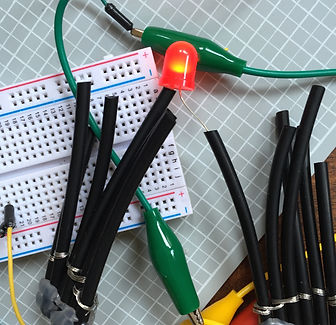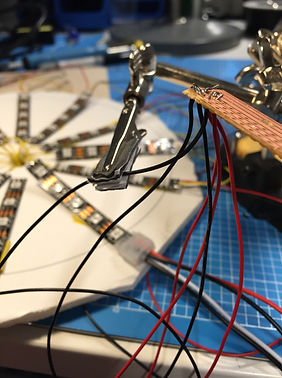Anemone Mood Lightscape
A Synaesthetic Interaction Using Touch and Sight to Communicate Mood

Techniques Used
Physical Computing Hardware Sketching Sketching
3D Printing Laser Cutting
Anemone Mood Lightscape is a working prototype of a device that facilitates synaesthetic interactions between tactile touch and visual stimulus. Users can input their current mood by stroking the Anemone roughly or softly, and the Lightscape would light up correspondingly.
Ideation
The inspiration for this Physical Computing and Prototyping project was the sensory and affective possibilities available when mixing & matching touch, sight, smell, and sound.
I wanted to create an interaction that was soothing and emotionally beneficial. Possible ideas included mixing these senses, with general ideas of different user groups:


Narrowing the Vision
The design process of local hill climbing continued as cohort gave feedback and suggestions.
The duvet idea was eliminated, as many people said it would be uncomfortable to have
flashing lights so close to ones face. SAD lights were also eliminated because they were too
costly to implement on the desired scale.

Greenberg, Carpendale, Marquardt, and Buxton, 2011
According to Amber Case in Calm Technology (2016), a well-designed affective technology accounts for human concerns such as usability, touch, access, emotions, and personal history. It not only respects humans’ limited amount of attention, but actually rewards it positively through constructive, emotional reinforcement.
I wanted to incorporate these factors into an ambient mood light display that responds according to touch.
Form Factor
I discovered that conductive silicon tubes that would support the desired tactile – visual response. The aesthetics and affordances of the silicon ‘noodles’ led to a playful anemone shape form factor.

Vertical Prototyping
After many input/output ideas were brainstormed, I decided to make a simple vertical prototype and go in-depth with one possible interaction for this mood lamp:

The user would stroke the anemone and the Neopixel lightscape would light up.
If the user stroked the anemone roughly, there would be more contact between the conductive tubes, and the brighter the Neopixels would glow brighter. Less contact would result in a softer glow.

Fabrication
Anemone
A low-fidelity prototype was made to understand how the anemone could be fabricated and electrically wired.
There would be two separate sets of conductive tubes, represented as red straws. Contact between the ‘conductive’ red straws would spark Neopixels to light up.




Wires were run between the conductive silicon tubes so they could be attached to the Arduino. Decorative tubes were added to hide the wires.
Instructable user, blorgggg, was a very helpful resource for conductive silicon advice.



The second iteration was a 3D printed case from Thingiverse user, mikebattaglia. Edits were made on Tinkercad to re-scale and add a opening for the wires. This case was robust enough and fit well into one’s palm and one’s lap for comfort.
Anemone Case
A case was needed to hold the anemone and hide the wires. A fractal look would fit the overall aesthetic of the project.
The first iteration was a laser-cut dodecahedron case from Thingiverse user, NewAmericanPublicArt. Laser-cutting was used because it allowed for a case with tilting and movement capabilities, but it was too delicate for the wear-and-tear a pet object would have to withstand.



Neopixel Lightscape
Neopixels would be the light supply, but a light diffusion material was needed. Various translucent material like bubble wrap and rice paper were considered.
Frosted polypropylene sheet was chosen to diffuse the light, and ProtoPaper was used to create a dynamic shape.


Sketching with Hardware
The use of the conductive silicon tubes were sketched and tested by using hardware. Alligator clips were used to connect the conductive tubes to the breadboard and an Arduino Uno was used as a power source.
The first sketch was done by placing each LED leg into a conductive tube module.
The second sketch was done by placing the LED into the breadboard and seeing whether it would light up when the tube modules made contact.





The 12 strips of Neopixels were wired and soldered together so the Arduino’s code data would reach all of the pixels.

The loose ground and volt wires were then soldered to a Veroboard to keep them centralized and neat.

The Neopixels were plugged in, lit up, and ready to go!

Assembling
The Neopixels and anemone were placed into their respective cases.


The amount of contact surface area between the two sets of conductive anemone modules determines how much voltage travels to the Neopixels. The more contact between the modules, the more voltage and the more light there would be. This enabled some nuance to the effect of the user’s touch.


Product
Anemone Mood Lightscape gives the user a synaesthetic interaction between tactile touch and visual stimulus. The Neopixel Lightscape lights up when the Anemone is petted, and the conductive tubes touch.
Evaluation
This vertical prototype was successful in exploring user responses to a synaesthetic interaction. Anemone Mood Lightscape was presented to users, who were attracted to the lights and described the interaction as fun, chill, and enjoyable.
However, interactions were short and choppy. Mood input is limited to forcefulness of strokes, and dependent on unpredictable area of contact between conductive silicon tubes during strokes. It became clear more meaningful interactivity needed to be incorporated to sustain long-term use.

The prototype leaned towards look & feel over implementation and role.
Future Work for More Interactivity
The next iteration would shift towards an ambient mood lightscape that remains lit according to the last mood input, instead of turning off when conductive tubes aren’t touching, making it into a time-piece.
Mood input would be: a forceful touch = rapid color transition and a light touch = slow, calm color transition. More conductive silicon anemone would be added to make light more nuanced. Auditory senses/music could potentially be added as well.